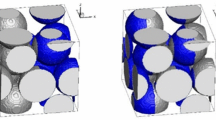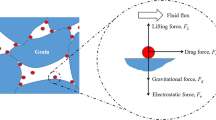Abstract
Understanding particle transport in porous media is critical in the sustainability of many geotechnical and geoenvironmental infrastructure. To date, the determination of the first-order rate coefficients in the advection–dispersion equation for simulating attachment and detachment of particles in saturated porous media typically has been relied on the result of laboratory-scale experiments. However, to determine attachment and detachment coefficients under varied hydraulic and geochemical variables, this method requires a large experimental matrix because each test provides only one set of attachment and detachment coefficients. The work performed in this study developed a framework to upscale the results obtained in pore-scale modeling to the continuum scale through the use of a pore network model. The developed pore network model incorporated variables of mean particle size, the standard deviation of particle size distribution, and interparticle forces between particles and sand grains. The obtained retention profiles using the pore network model were converted into attachment coefficients in the advection–dispersion equation for long-term and large-scale simulation. Additionally, by tracking individual particles during and after the simulation, the pore network model introduced in this study can also be employed for modeling the clogging phenomenon, as well as fundamental investigation of the impact of particle size distribution on particle retention in the sand medium.









Similar content being viewed by others
Abbreviations
- A (M L2 T−1):
-
Hamaker constant
- C 0, C (M L−3):
-
Inlet concentration and particle concentration
- d 50 (L):
-
Median grain size of sand
- D ij (L):
-
The Euclidean distance between centers of pore i and j
- d p, d t (L):
-
Diameter of the pore and throats
- g t, g p (M−1 L4 T):
-
Hydraulic conductances of throats and the half of pores
- h 0 (L):
-
Minimum separation distance
- i,j :
-
Pore index
- J T (M L−3 T−1):
-
Total particle flux
- k (L T−1):
-
Hydraulic conductivity
- k att, k det (T−1):
-
First-order coefficients for attachment and detachment
- K 1 :
-
Pore wall correction factor
- L ij (L):
-
The length of the throat between pore i and pore j
- L ref (L):
-
Reference length
- M ij (M):
-
Transferred mass of particles from pore i to pore j
- n :
-
Porosity
- N c :
-
Total number of sampled particles
- P (M L T−2):
-
Pressures at pores
- p cap :
-
Capture probability
- p m :
-
Cumulative probability of mth interval
- Q ij (L3 T−1):
-
The flow rate between pore i and j
- r c , r t (L):
-
Radius of particle and throat
- r new (L):
-
Updated effective throat radius
- r p (L):
-
Radius of pores
- S att, S max (M M−1):
-
Solid phase attached particles and attachment capacity
- t, Δt (T):
-
Time and time for one time step
- U (L T−1):
-
Centerline velocity of throats
- v, v c (L T−1):
-
Velocity of water and critical velocity
- V inlet (L3):
-
Total volume of inlet pores
- ΔP p, ΔP total (M L T−2):
-
Pressure drop at a throat and total pressure drop
- θ, θ 0 :
-
Lumped parameter and interparticle force parameter
- Μ (M L− 1 T− 1):
-
Viscosity of water
- μ c, σ c :
-
Mean and standard deviation of particle size distribution
- ρ s, ρ b (M L−3):
-
Density of particle and bulk density of sand
- ψ att :
-
Attachment function
References
Aghighi M, Hoeh MA, Lehnert W et al (2016) Simulation of a full fuel cell membrane electrode assembly using pore network modeling. J Electrochem Soc 163:F384–F392. https://doi.org/10.1149/2.0701605jes
Auset M, Keller A (2006) Pore-scale visualization of colloid straining and filtration in saturated porous media using micromodels. Water Resour Res. https://doi.org/10.1029/2005WR004639
Bradford SA, Kim H (2010) Implications of cation exchange on clay release and colloid-facilitated transport in porous media. J Environ Qual 39:2040. https://doi.org/10.2134/jeq2010.0156
Bradford SA, Simunek J, Bettahar M et al (2003) Modeling colloid attachment, straining, and exclusion in saturated porous media. Environ Sci Technol 37:2242–2250. https://doi.org/10.1021/es025899u
Bradford SA, Torkzaban S, Simunek J (2011) Modeling colloid transport and retention in saturated porous media under unfavorable attachment conditions. Water Resour Res. https://doi.org/10.1029/2011WR010812
Bradford SA, Torkzaban S, Walker SL (2007) Coupling of physical and chemical mechanisms of colloid straining in saturated porous media. Water Res 41:3012–3024. https://doi.org/10.1016/j.watres.2007.03.030
Bradford SA, Yates SR, Bettahar M, Simunek J (2002) Physical factors affecting the transport and fate of colloids in saturated porous media. Water Resour Res 38:63-1–63-12. https://doi.org/10.1029/2002WR001340
Compère F, Porel G, Delay F (2001) Transport and retention of clay particles in saturated porous media. Influence of ionic strength and pore velocity. J Contam Hydrol 49:1–21. https://doi.org/10.1016/S0169-7722(00)00184-4
Dai S, Seol Y (2014) Water permeability in hydrate-bearing sediments, a pore scale study. Geophys Res Lett 41:4176–4184. https://doi.org/10.1002/2014GL060535.Received
Delgado JMPQ (2007) Longitudinal and transverse dispersion in porous media. Chem Eng Res Des 85:1245–1252. https://doi.org/10.1205/cherd07017
Gostick J, Aghighi M, Hinebaugh J et al (2016) OpenPNM: a pore network modeling package. Comput Sci Eng 18:60–74. https://doi.org/10.1109/MCSE.2016.49
Gu DM, Huang D, Liu HL et al (2019) A DEM-based approach for modeling the evolution process of seepage-induced erosion in clayey sand. Acta Geotech 14:1629–1641
Hajra MG, Reddi LN, Glasgow LA et al (2002) Effects of ionic strength on fine particle clogging of soil filters. J Geotech Geoenviron Eng 128:631–639. https://doi.org/10.1061/(ASCE)1090-0241(2002)128:8(631)
Happel J, Brenner H (2012) Low Reynolds number hydrodynamics: with special applications to particulate media, 1st edn. Springer, Berlin
Harvey RW, Garabedian SP (1991) Use of colloid filtration theory in modeling movement of bacteria through a contaminated sandy aquifer. Environ Sci Technol 25:178–185. https://doi.org/10.1021/es00013a021
Hu Z, Zhang Y, Yang Z (2019) Suffusion-induced deformation and microstructural change of granular soils: a coupled CFD–DEM study. Acta Geotech 14:795–814
Imdakm AO, Sahimi M (1991) Computer simulation of particle transport processes in flow through porous media. Chem Eng Sci 46:1977–1993. https://doi.org/10.1016/0009-2509(91)80158-U
Israelachvili JN (2011) Intermolecular and surface forces: revised, 3rd edn. Academic press, London
Kuznar ZA, Elimelech M (2007) Direct microscopic observation of particle deposition in porous media: role of the secondary energy minimum. Colloids Surf A Physicochem Eng Asp 294:156–162. https://doi.org/10.1016/j.colsurfa.2006.08.007
Litton GM, Olson TM (1996) Particle size effects on colloid deposition kinetics: evidence of secondary minimum deposition. Colloids Surf A Physicochem Eng Asp 107:273–283. https://doi.org/10.1016/0927-7757(95)03343-2
Luo Y, Huang Y (2020) Effect of open-framework gravel on suffusion in sandy gravel alluvium. Acta Geotech. https://doi.org/10.1007/s11440-020-00933-9
Luo Y, Luo B, Xiao M (2019) Effect of deviator stress on the initiation of suffusion. Acta Geotech 15:1607–1617. https://doi.org/10.1007/s11440-019-00859-x
Mackie RI, Horne RMW, Jarvis RJ (1987) Dynamic modeling of deep-bed filtration. AIChE J 33:1761–1775. https://doi.org/10.1002/aic.690331102
McCarthy JF, Zachara JM (1989) Subsurface transport of contaminants. Environ Sci Technol 23:496–502. https://doi.org/10.1021/es00063a001
Nguyen CD, Benahmed N, Andò E et al (2019) Experimental investigation of microstructural changes in soils eroded by suffusion using X-ray tomography. Acta Geotech 14:749–765
Pirnia P, Duhaime F, Ethier Y, Dubé J-S (2020) Hierarchical multiscale numerical modelling of internal erosion with discrete and finite elements. Acta Geotech. https://doi.org/10.1007/s11440-020-01009-4
Raoof A, Nick HM, Hassanizadeh SM, Spiers CJ (2013) PoreFlow: a complex pore-network model for simulation of reactive transport in variably saturated porous media. Comput Geosci 61:160–174. https://doi.org/10.1016/j.cageo.2013.08.005
Reddi LN, Xiao M, Hajra MG, Lee IM (2005) Physical clogging of soil filters under constant flow rate versus constant head. Can Geotech J 42:804–811. https://doi.org/10.1139/t05-018
Rege SD, Fogler HS (1988) A network model for deep bed filtration of solid particles and emulsion drops. AIChE J 34:1761–1772. https://doi.org/10.1002/aic.690341102
Schijven JF, Hassanizadeh SM (2000) Removal of viruses by soil passage: overview of modeling, processes, and parameters. Crit Rev Environ Sci Technol 30:49–127. https://doi.org/10.1080/10643380091184174
Tranter TG, Gostick JT, Burns AD, Gale WF (2016) Pore network modeling of compressed fuel cell components with OpenPNM. Fuel Cells 16:504–515. https://doi.org/10.1002/fuce.201500168
Valvatne PH, Piri M, Lopez X, Blunt MJ (2005) Predictive pore-scale modeling of single and multiphase flow. In: Das D, Hassanizadeh S (eds) Upscaling multiphase flow in porous media. Springer, Dordrecht, pp 23–41
Won J, Burns SE (2017) Influence of ionic strength on clay particle deposition and hydraulic conductivity of a sand medium. J Geotech Geoenviron Eng 143:04017081. https://doi.org/10.1061/(ASCE)GT.1943-5606.0001780
Xiong Q, Baychev TG, Jivkov AP (2016) Review of pore network modelling of porous media: experimental characterisations, network constructions and applications to reactive transport. J Contam Hydrol 192:101–117. https://doi.org/10.1016/j.jconhyd.2016.07.002
Yang J, Yin Z-Y, Laouafa F, Hicher P-Y (2019) Modeling coupled erosion and filtration of fine particles in granular media. Acta Geotech 14:1615–1627
Yuan H, Shapiro A, You Z, Badalyan A (2012) Estimating filtration coefficients for straining from percolation and random walk theories. Chem Eng J 210:63–73. https://doi.org/10.1016/j.cej.2012.08.029
Zhang F, Damjanac B, Huang H (2013) Coupled discrete element modeling of fluid injection into dense granular media. J Geophys Res Solid Earth 118:2703–2722. https://doi.org/10.1002/jgrb.50204
Acknowledgements
This material is based upon work supported by the Georgia Department of Transportation. Any opinions, findings, and conclusions or recommendations expressed in this material are those of the writers and do not necessarily reflect the views of the Georgia Department of Transportation. Special thanks are given to Mr. J.D. Griffith, P.E., P.G. (deceased) for his support of this research project.
Author information
Authors and Affiliations
Corresponding author
Additional information
Publisher's Note
Springer Nature remains neutral with regard to jurisdictional claims in published maps and institutional affiliations.
Electronic supplementary material
Below is the link to the electronic supplementary material.
Rights and permissions
About this article
Cite this article
Won, J., Lee, J. & Burns, S.E. Upscaling polydispersed particle transport in porous media using pore network model. Acta Geotech. 16, 421–432 (2021). https://doi.org/10.1007/s11440-020-01038-z
Received:
Accepted:
Published:
Issue Date:
DOI: https://doi.org/10.1007/s11440-020-01038-z




